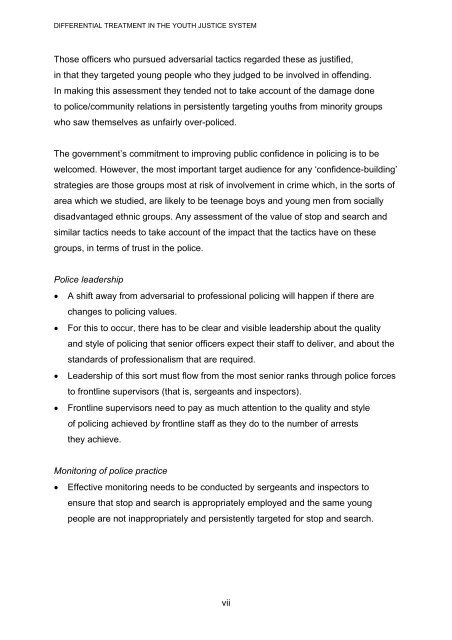Differential treatment in the youth justice system - Equality and ...
Differential treatment in the youth justice system - Equality and ...
Differential treatment in the youth justice system - Equality and ...
Create successful ePaper yourself
Turn your PDF publications into a flip-book with our unique Google optimized e-Paper software.
DIFFERENTIAL TREATMENT IN THE YOUTH JUSTICE SYSTEMThose officers who pursued adversarial tactics regarded <strong>the</strong>se as justified,<strong>in</strong> that <strong>the</strong>y targeted young people who <strong>the</strong>y judged to be <strong>in</strong>volved <strong>in</strong> offend<strong>in</strong>g.In mak<strong>in</strong>g this assessment <strong>the</strong>y tended not to take account of <strong>the</strong> damage doneto police/community relations <strong>in</strong> persistently target<strong>in</strong>g <strong>youth</strong>s from m<strong>in</strong>ority groupswho saw <strong>the</strong>mselves as unfairly over-policed.The government’s commitment to improv<strong>in</strong>g public confidence <strong>in</strong> polic<strong>in</strong>g is to bewelcomed. However, <strong>the</strong> most important target audience for any ‘confidence-build<strong>in</strong>g’strategies are those groups most at risk of <strong>in</strong>volvement <strong>in</strong> crime which, <strong>in</strong> <strong>the</strong> sorts ofarea which we studied, are likely to be teenage boys <strong>and</strong> young men from sociallydisadvantaged ethnic groups. Any assessment of <strong>the</strong> value of stop <strong>and</strong> search <strong>and</strong>similar tactics needs to take account of <strong>the</strong> impact that <strong>the</strong> tactics have on <strong>the</strong>segroups, <strong>in</strong> terms of trust <strong>in</strong> <strong>the</strong> police.Police leadership• A shift away from adversarial to professional polic<strong>in</strong>g will happen if <strong>the</strong>re arechanges to polic<strong>in</strong>g values.• For this to occur, <strong>the</strong>re has to be clear <strong>and</strong> visible leadership about <strong>the</strong> quality<strong>and</strong> style of polic<strong>in</strong>g that senior officers expect <strong>the</strong>ir staff to deliver, <strong>and</strong> about <strong>the</strong>st<strong>and</strong>ards of professionalism that are required.• Leadership of this sort must flow from <strong>the</strong> most senior ranks through police forcesto frontl<strong>in</strong>e supervisors (that is, sergeants <strong>and</strong> <strong>in</strong>spectors).• Frontl<strong>in</strong>e supervisors need to pay as much attention to <strong>the</strong> quality <strong>and</strong> styleof polic<strong>in</strong>g achieved by frontl<strong>in</strong>e staff as <strong>the</strong>y do to <strong>the</strong> number of arrests<strong>the</strong>y achieve.Monitor<strong>in</strong>g of police practice• Effective monitor<strong>in</strong>g needs to be conducted by sergeants <strong>and</strong> <strong>in</strong>spectors toensure that stop <strong>and</strong> search is appropriately employed <strong>and</strong> <strong>the</strong> same youngpeople are not <strong>in</strong>appropriately <strong>and</strong> persistently targeted for stop <strong>and</strong> search.vii






